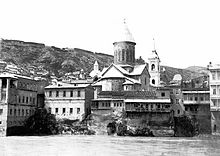Sioni Cathedral
The Sioni Cathedral ( Georgian სიონის ეკლესია ) is a church building in the Georgian capital Tbilisi . It was built between 575 and 639. It is considered to be one of the most sacred places in Georgian Orthodoxy.

Until 2004 the cathedral was the seat of the Patriarch of the Georgian Orthodox Apostle Church and Archbishop of Mtskheta -Tiflis, Ilia II. It was named after Mount Zion in Jerusalem and is dedicated to the Virgin Mary .
After several destruction and reconstructions, nothing remains of the original church building above ground. The current yellow tufa building of the church dates from the 17th to 19th centuries. As early as the 12th century, the church had changed its appearance after a reconstruction: The floor plan - an inscribed cross with two cantilevered pillars, an extended western cross arm and a protruding apse - has since then corresponded to the main church of the Gelati monastery from the 12th century and the Church of the Virgin Mary in the Schiomgwime Monastery.
In 1425 the sacred building was supplemented by a free-standing three-story bell tower. It was destroyed in 1795 and rebuilt in 1939. In 1812 another three-story bell tower was built in the classic Russian style on the opposite side of the street.
The church has housed various valuable relics since the early 14th century : These include the skull of the Apostle Thomas and the vine cross of Saint Nino , a young woman who was equated with the apostles and who brought Christianity to Georgia in the early 4th century . They are located in shrines housed in the main iconostasis of the church. The walls show frescoes by the Russian artist Grigori Gagarin, who painted over older frescoes from 1850 to 1860.
On April 12, 1802, the church became a political venue. After the annexation of Georgia by Russia, the Russian general Carl Heinrich von Knorring forced the Georgian aristocracy and clergy gathered there to take the oath of the Russian imperial crown by force of arms . Dignitaries who objected were arrested on the spot by soldiers.
There are also Sioni churches in Georgian Bolnissi , in Ateni, on Georgian Army Road and in Rustavi . The one in Bolnisi dates from the 5th century, the one in Ateni from the 11th century, in Rustavi the Sioni Church was rebuilt from 2000 to 2011.
The newly built Trinity Cathedral in Tbilisi has been the seat of the Georgian Patriarchate since 2004 .
literature
- V. Beridze: The sacred architecture of Georgia in the 16th - 18th centuries. Tbilisi 1994 (Georgian).
- T. Kiparoidze: Recently discovered remains of old construction work on the Sioni Cathedral. In: Dzeglis Megobari , 50, 1970 (Georgian).
- Description of the monuments of Georgian history and culture. Ed. 5, Tbilisi 1990 (Georgian).
Web links
Coordinates: 41 ° 41 ′ 29 ″ N , 44 ° 48 ′ 27 ″ E


